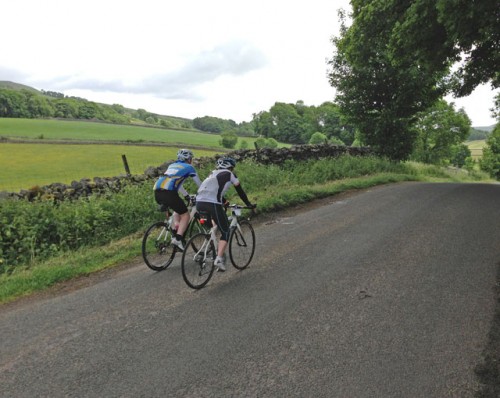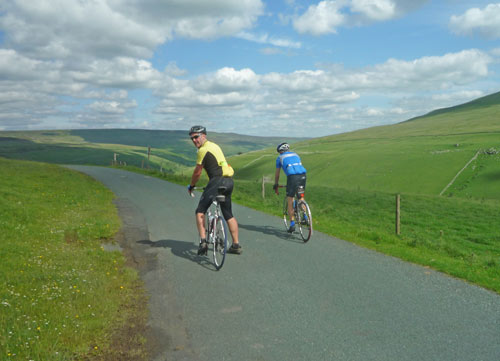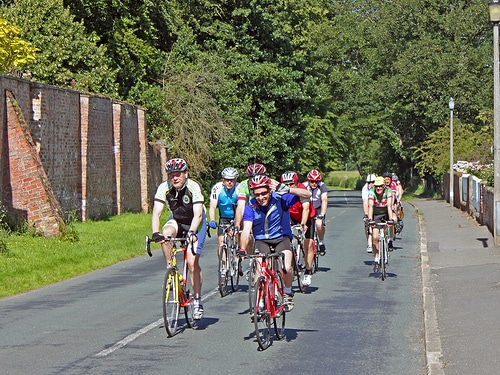I began cycling in the early 1990s, aged about 14. After a few rides on my own, I was invited by a friend, Sam Ward, to join Otley CC and take part in their Sunday rides. The club would meet every Sunday at 9am by the butter cross market in the centre of Otley.

In those days cycling was a much smaller sport, it was more on the fringe of society. So to see 60 plus cyclists sitting around Otley town centre made quite an impression. Joining a cycling club was pretty exciting for a young keen cyclist. It made you feel part of something, a nice change from ploughing a lonely furrow. Everyone looked as though they were wizened cyclists with plush bikes and years of experience. I assumed that everyone would be ridiculously fit and fast after training for the past 20 + years. I was nervous about getting dropped so, initially joined the ‘slow group’. After a few weeks I made the jump to the intermediates, and then after a few months I graduated to the ‘A’ Group led by Jack. However, I never made the jump to the fourth group. The fourth group were called the ‘fast’ group and were comprised of guys who would spend all summer racing. They looked suitably fast and I was too intimidated to ever consider joining the guys who raced. I assumed it would be 25mph all the way to the tea shop, I didn’t want to embarrass myself by making people wait on the climbs. So I stuck with the older men and women in the A group. We may not have been fast, but we did clock up the miles!
Rules of the road
One golden rule drummed into me from an early age, is make sure you have mudguards in winter, otherwise you’re at the back! I remember spending hours trying to fit these old fashioned fiddly mudguards with nuts and bolts, a far cry from todays clip on mudguards. Not everything is golden about the past. I only had one bike in those days – a good old Reynolds 501 frame costing £200 from Ellis Briggs in Shipley. It probably weighed a ton, but I never gave a passing thought to the weight of components in those days. It had drop handlebars and I knew that made me a ‘proper’ cyclist!

Apart from mudguards in winter, there weren’t really any rules about club runs, but there were some general principles. Firstly, no-body would get dropped. If someone was slow on the hills, we would always wait. I remember one occasion, when some young lads tacked onto the club run, but they didn’t realise how far we were going. I think they got confused between group B and group A. One poor boy was suffering like anything – 40 miles from home. But, the group leaders made sure we got them home, even if it meant averaging 11mph all the way home, pushing the young boy up the climb and giving him some jam sandwiches.
That camaraderie was a special feature of the club runs. I remember one winter club run and my hands were freezing. I kept shoving my hands up my jersey, blowing on them, everything to try and keep them from freezing. An older member saw my plight and just took off his gloves and gave them to me for the ride. I didn’t even know him. But, I really appreciated the gloves.
15mph all day.
Needless to say there was never any half-wheeling or attacking on a club run. It was all at a sensible pace, without any competitive spirit. Once or twice a year there would be ‘reliability rides’ usually 50 miles in 3 hours. But, generally we would average 15mph for a days riding. But to do 100 miles, would still take 8 hours because any club run invariably involved 2 or 3 cafe stops. With more time for a good chat. Perhaps people had more time, but we would think of nothing to leaving the house at 9am and get back at 5pm.
Miles, more miles

Sunday club runs were gloriously unconcerned with modern training methods of intervals and heart rate zones, not to speak of meaningless GPS segments. It was all about miles and enjoying the cycling. The thing I most enjoyed about the club runs were doing huge distances that I would never have considered possible on my own. Each club run became an opportunity to go further than before. I remember after some club runs returning home utterly exhausted. The last incline of the day Otley to Menston (Ellar Ghyll) may have been only 20 metres elevation gain, but I would often do it at walking pace because I was totally spent after cycling 100 miles. The sense of achievement was really quite something. I loved that feeling of tiredness. To replicate it, I would probably have to take a long break from cycling and then do a 100 mile ride with relatively little training. My only regret was not doing the famous Morecambe 150 mile ride. I was always put off by distance, but I think I could have done it.
In summer, our group leader – mile muncher Jack – would sometimes start the A group off at 8am, so we could go even further. This would enable us to make exotic locations like Muker in Swaledale, Sedbergh in Dentdale. Memorable rides.
Yorkshire Dales

Another aspect of the Otley CC club runs which were so appealing was we were in a very fortunate location. The Yorkshire Dales were within easy reach. Every ride was in beautiful surroundings which encouraged the touring mindset.
Cycling two abreast

The 1990s weren’t exactly the halcyon days of the 1950s when bicycles outnumbered cars 100 to 1. But, I don’t remember much conflict with cars. On Sundays, the roads seemed fairly quite. We would always seek out the quietest roads and for most of the time were able to cycle two abreast. If a car got stuck behind, someone would shout, ‘car up’ and we would single out allowing the car to pass. There were probably a few impatient drivers, but nothing I can particularly remember. It seemed quite easy to co-exist with other cars. You definitely felt a greater sense of security riding in a pack of 8-10 riders. I always followed the leadership of the older members, but we always seemed considerate to other road users. Sundays were a popular day for other club runs and we would often bump into other clubs going out for their ride, like Airedale Olympic and Harrogate Nova.
Read more








